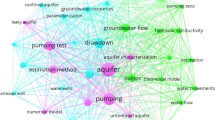Abstract
In this study, a three-dimensional model was used to numerically study the buoyant flow characteristics of heated water discharged from the submerged side outfalls in shallow and deep water. Hydraulic experimental data was used to evaluate the applicability of the model. The simulation results for model verification are in good accordance with experimental results. For shallow waters, the discharge jet is deflected by the river crossflow while forcing the river flow to bend towards the far bank over the depth. The unidirectional flow is dominant all over the depth in they-z cross section. In the case of submerged discharge with shallow water especially, the recirculating zone is the largest in the lowest layer, becoming smaller in the upper layer. As water depth increases, the ambient flow goes over the jet and thus diminishes the blocking effect so that jet bending decreases. Counterclockwise circulation and local eddies form with the increase of depth. Based on the viewpoint of rapid mixing and the dimension of the recirculating zone, submerged discharge appears more efficient than surface discharge.
Similar content being viewed by others
References
Adams, E.E. and Stolzenbach, K.D. (1974). “Zone models for the near-field: surface discharge in European course on heat disposal from power generation in the water environment.” Chap. 7, Delft Hydraulics Laboratory.
Flow Science (2003).FLOW-3D. [Theory manual]. Los Alamos, NM.
Koester, G.E. (1974). “Experimental study of submerged single-port thermal discharges.” S.M. [Dissertation]. Dept. of Civil Engineering, M.I.T., Cambridge, Massachusetts.
Lee, N.J., Choi, H.S., and Lee, K.S. (1994). “A comparative study of two-dimensional numerical models for surface discharge of heated water into crossflow field.”Journal of the Korean Society of Coastal and Ocean Engineers, Vol. 6, No. 1, pp. 40–50.
Lee, N.J., Choi, H.S., and Huh, J.Y. (1995). “A three-dimensional turbulence model for the thermal discharge into cross-flow field.”Journal of the Korean Society of Coastal and Ocean Engineers, Vol. 7, No. 2, pp. 148–155.
McGuirk, J.J. and Rodi, W. (1978). “A depth-averaged mathematical model for the near field of the side discharge into open-channel flow.”J. of Fluid Mech., Vol. 86, No. 4, pp. 761–781.
McGuirk, J.J. and Rodi, W. (1979). “Mathematical modeling of three-dimensional heated surface jets.”J. of Fluid Mech., Vol. 95, No. 4, pp. 609–633.
Mikhail, R., Chu, V.H., and Savage, S.B. (1975). “The reattachment of a two-dimensional turbulent jet in a confined cross flow.”Proc. 16th IAHR Cong. Sao Paulo, Brazil, Vol. 3, pp. 414–419.
Park, S.W. and Chung, M.K. (1983). “Prediction of 2-dimensional unsteady thermal discharge into a reservoir.”Journal of the Korean Society of Mechanical Engineers, Vol. 7, No. 4, pp. 451–460.
Stolzenbach, K.D., Adams, E.E., and Harleman, D.R.F. (1972). “A user's manual for three-dimensional heated surface discharge conditions.” R.M. Parsons Laboratory for Water Resources and Hydrodynamics. Dept. of Civil Engineering, M.I.T., Technical Report No. 156.
Yakhot, V., Orsarg, S.A., Thangam, S., Gatski, T.B., and Speziale, C.G. (1992). “Development of turbulence models for shear flows by a double expansion technique.”Physics of Fluids, Vol. 4, No. 7, pp. 1510–1520.
Author information
Authors and Affiliations
Rights and permissions
About this article
Cite this article
Kim, D.G., Seo, I.W. Numerical simulations of the buoyant flow of heated water discharged from submerged side outfalls in shallow and deep water. KSCE J Civ Eng 8, 255–263 (2004). https://doi.org/10.1007/BF02829126
Received:
Accepted:
Issue Date:
DOI: https://doi.org/10.1007/BF02829126




